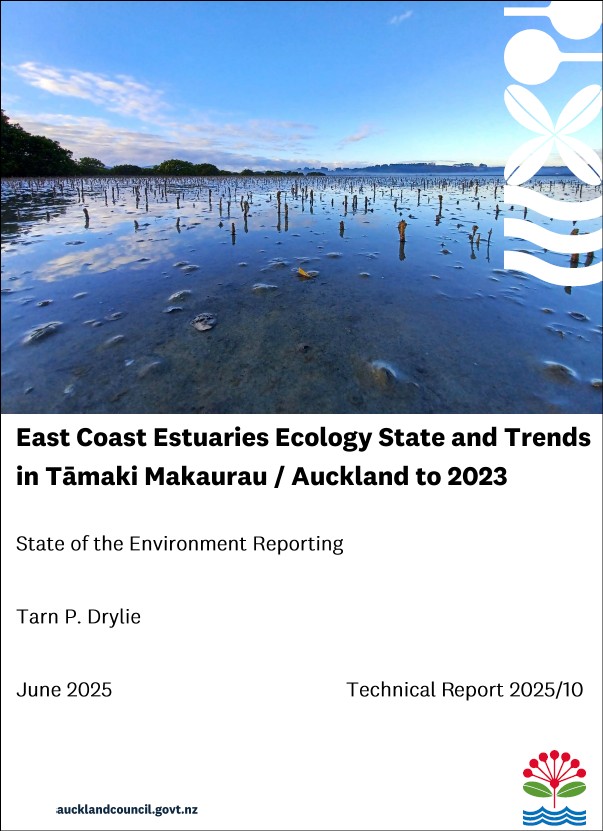East coast estuaries ecology state and trends in Tāmaki Makaurau / Auckland to 2023
Author:
Tarn P DrylieSource:
Auckland Council Environmental Evaluation and Monitoring Unit, EEMU | Engineering, Assets and Technical Advisory DepartmentPublication date:
2025Topics:
EnvironmentEast coast estuaries ecology state and trends in Tāmaki Makaurau / Auckland to 2023. State of the environment reporting
Executive summary
Estuaries that are healthy provide benefits to people in the form of ecosystem services. These services include climate regulation, food production, nutrient and water cycling and opportunities for cultural and recreational fulfilment. A healthy estuary is also resilient to disturbances, whether natural (from storms, for example) or man-made (such as pollution). This report provides technical information describing the current state (or ‘health’) of small estuaries along Tāmaki Makaurau / Auckland’s east coast and how estuary health has changed over time.
The East Coast Estuaries Ecology monitoring programme was initiated in 2000 and monitors 77 sites across eight of the region’s smaller estuaries: Whangateau Harbour, Pūhoi River, Waiwera River, Ōrewa River, Ōkura River, Mangemangeroa Creek, Tūranga Creek and Waikōpua Creek. The programme was designed to monitor any changes in the estuaries resulting from population growth and development in their surrounding catchments.
According to the Combined Health Score, only 28 per cent of the intertidal sandflat sites were in ‘Excellent’ or ‘Good’ health whereas 71 per cent were ‘Fair’ or ‘Marginal’ in 2023. Only one site, PUH10, had ‘Poor’ overall health (one per cent). The distribution of sites among Combined Health Score categories had degraded since the last regional assessment in 2019; fewer sites were in ‘Excellent’ (three per cent, down from 11 per cent) or ‘Good’ health (25 per cent down from 34 per cent) and more were in ‘Poor’ health (one site in 2023 compared to no sites in 2019). On average, 23 species of macrofauna (invertebrates larger than 0.5 mm) were found at each site, and 56 per cent of sites had ‘High’ functional resilience according to the Traits-Based Index.
The ecological health of monitoring sites tended to be better in the lower estuary close to the estuary mouth and poorer in the upper estuary close to freshwater inflows. Exceptions occurred where sites in the lower estuary were located in sheltered, low energy areas where the flushing potential is likely to be low and pollutants (such as sediment and metal contaminants) are more likely to settle, or where the natural hydrodynamics of the estuary were altered (for example at Waiwera and Whangateau where causeways may have disrupted tidal flows and impacted health).
Excess land-derived sediment (fine silts and clays) was the most prevalent stressor of ecological health over the monitoring period, impacting every estuary to some degree. Whangateau Harbour exhibited the fewest long-term trends consistent with sedimentation while Mangemangeroa, Ōkura and Waikōpua exhibited the most. Some recent changes in indicators that might suggest contemporary (as opposed to legacy) impacts from sedimentation were also found in most estuaries. These included an increase in the concentration of very fine sediments, a degradation in the health group assigned by the Benthic Health Model for mud or a change in the abundance of indicator species that occurred within the last five years. Notably, potential recovery from sedimentation impacts was evident at sites in the Tūranga and Waikōpua Creeks (in the form of improving health indices and increasing abundances of sediment-sensitive species). Results from sediment accretion monitoring were presented alongside the ecology data for the first time, which aided the interpretation of trends related to sediment impacts.
There was some evidence of metal contamination having caused stress to benthic communities over the monitoring period, though this was often difficult to separate from the impacts of sedimentation, and there was little evidence to suggest that metals impacted ecological health in any estuary over the last five years. Effective indicators of nutrient enrichment are lacking from the East Coast Estuaries Ecology monitoring programme given the focus on terrestrial sediment impacts, however at more than one site in Ōrewa River and Waikōpua Creek, potential symptoms of excess nutrients were observed. Co-occurring increases in the concentration of organic content and chlorophyll a may indicate a nutrient enrichment issue and it is recommended this is investigated via a survey of sediment nutrient concentrations.
Auckland Council technical report, TR2025/10
September 2025
See also
